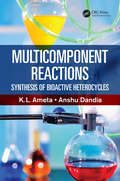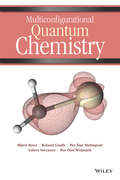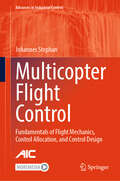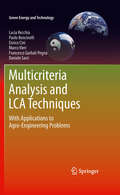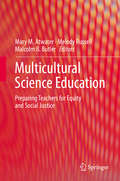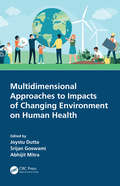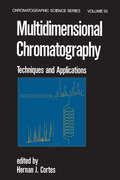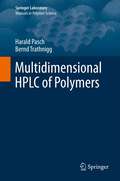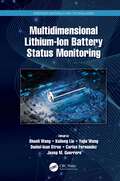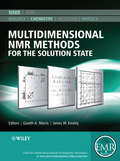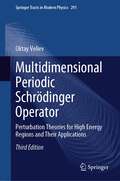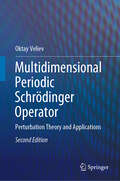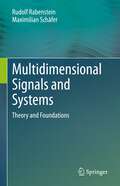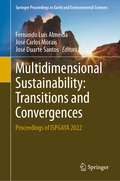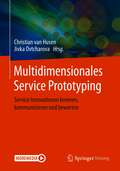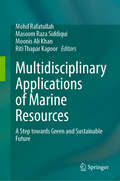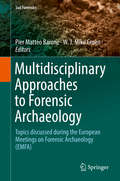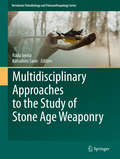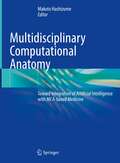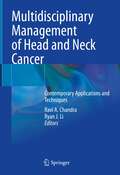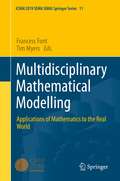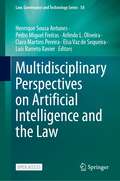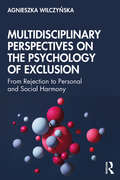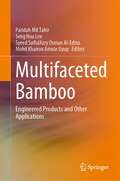- Table View
- List View
Multicomponent Reactions: Synthesis of Bioactive Heterocycles
by K. L. Ameta Anshu DandiaThis timely book provides a succinct summary of methods for the synthesis of bioactive heterocycles using a multicomponent reaction (MCR) approach. The majority of pharmaceuticals and biologically active agrochemicals are heterocycles while countless additives and modifiers used in industrial applications are heterocyclic in nature. With the recent introduction of high-throughput biological evaluation, the importance of MCRs for drug discovery has been recognized and considerable efforts have been focused especially on the design and development of multi-component procedures for the generation of various bioactive heterocycles due to their significant therapeutic potential.
Multiconfigurational Quantum Chemistry
by Per-Olof Widmark Per Åke Malmqvist Roland Lindh Björn O. Roos Valera VeryazovThe first book to aid in the understanding of multiconfigurational quantum chemistry, Multiconfigurational Quantum Chemistry demystifies a subject that has historically been considered difficult to learn. Accessible to any reader with a background in quantum mechanics and quantum chemistry, the book contains illustrative examples showing how these methods can be used in various areas of chemistry, such as chemical reactions in ground and excited states, transition metal and other heavy element systems. The authors detail the drawbacks and limitations of DFT and coupled-cluster based methods and offer alternative, wavefunction-based methods more suitable for smaller molecules.
Multicopter Flight Control: Fundamentals of Flight Mechanics, Control Allocation, and Control Design (Advances in Industrial Control)
by Johannes StephanThis book presents a comprehensive discussion of the mechanical modelling and control of multicopters, more commonly referred to as drones. By selecting concepts for presentation based on their ease of comprehension and suitability for practical application, the author employs a straightforward and concise approach. A main objective is to examine both the theoretical and practical aspects, as well as their interrelationship. The book presents the fundamental functional algorithms of a multicopter flight control system, specifically: control allocation, or the distribution of a control demand among redundant actuators; low-level control loops to control rotational and vertical motion; simple guidance loops controlling the translational motion of a multicopter; and an introduction to Kalman filtering, which addresses the fusion of direct sensor measurement in order to estimate the state of the drone. These methods enable remotely piloted operation and preplanned path following. Multicopter Flight Control will be of particular interest to academic researchers and graduate students working in the field of aerospace engineering, as well as to practising engineers engaged in the development of drones and electric vertical take-off and landing aircraft. It provides a comprehensive and practical guide to the fundamentals of flight control and guidance techniques, offering valuable insights for those seeking to gain a deeper understanding of these topics. In order to derive the greatest benefit from reading this monograph, readers should possess a fundamental understanding of multiple-input, multiple-output system theory, particularly state-space representation, stability and feedback control. Additionally, a basic comprehension of rotor aerodynamics and rigid-body dynamics is essential.
Multicriteria Analysis and LCA Techniques
by Francesco Garbati Pegna Paolo Boncinelli Marco Vieri Daniele Sarri Enrico Cini Lucia RecchiaMulticriteria Analysis and LCA Techniques introduces the reader to the basic principles of multicriteria analysis (MCA) and life cycle assessment (LCA) techniques. The use of these tools is rapidly becoming essential in any feasibility study for comparing different solutions, selecting the most suitable ones, and for analyzing the interface of economy and environment. The main feature of Multicriteria Analysis and LCA Techniques is the application of a new approach to the analysis of energy balance and environmental impact of agro-industrial production chains. It gives detailed descriptions of a number of food and non-food agro-industrial applications of MCA and LCA, thereby providing the reader with practical examples of the implementation of these tools in the field of agro-industry. Multicriteria Analysis and LCA Techniques represents a subsidiary reference book for both undergraduate and graduate students, and can also be used for basic or applied academic research.
Multicultural Psychology
by Jeffery Scott Mio Lori A. Barker John Gonzalez Melanie M. Domenech RodríguezMulticultural Psychology combines quantitative and qualitative research with anecdotal material to examine an array of multicultural issues and capture the richness of diverse cultures. The text focuses on such compelling topics as differences in world views, communication, racial and cultural identity, development, racism, and immigration. Other issues covered in the text include gender, sexuality, age, and ability. The authors provide a strong, vivid, and personal voice to the text, richly populating it with anecdotes from themselves, their students, and other contributors and using these as central points around which to build their case for multicultural issues based on science.
Multicultural Science Education
by Malcolm B. Butler Mary M. Atwater Melody RussellThis book offers valuable guidance for science teacher educators looking for ways to facilitate preservice and inservice teachers'' pedagogy relative to teaching students from underrepresented and underserved populations in the science classroom. It also provides solutions that will better equip science teachers of underrepresented student populations with effective strategies that challenge the status quo, and foster classrooms environment that promotes equity and social justice for all of their science students. Multicultural Science Education illuminates historically persistent, yet unresolved issues in science teacher education from the perspectives of a remarkable group of science teacher educators and presents research that has been done to address these issues It centers on research findings on underserved and underrepresented groups of students and presents frameworks, perspectives, and paradigms that have implications for transforming science teacher education In addition, the chapters provide an analysis of the socio-cultural-political consequences in the ways in which science teacher education is theoretically conceptualized and operationalized in the United States. The book provides teacher educators with a framework for teaching through a lens of equity and social justice, one that may very well help teachers enhance the participation of students from traditionally underrepresented and underserved groups in science, technology, engineering, and mathematics (STEM) areas and help them realize their full potential in science. Moreover, science educators will find this book useful for professional development workshops and seminars for both novice and veteran science teachers. "Multicultural Science Education: Preparing Teachers for Equity and Social Justice directly addresses the essential role that science teacher education plays for the future of an informed and STEM knowledgeable citizenry. The editors and authors review the beginnings of multicultural science education, and then highlight findings from studies on issues of equity, underrepresentation, cultural relevancy, English language learning, and social justice. The most significant part of this book is the move to the policy level--providing specific recommendations for policy development, implementation, assessment and analysis, with calls to action for all science teacher educators, and very significantly, all middle and high school science teachers and prospective teachers. By emphasizing the important role that multicultural science education has played in providing the knowledge base and understanding of exemplary science education, Multicultural Science Education: Preparing Teachers for Equity and Social Justice gives the reader a scope and depth of the field, along with examples of strategies to use with middle and high school students. These classroom instructional strategies are based on sound science and research. Readers are shown the balance between research-based data driven models articulated with successful instructional design. Science teacher educators will find this volume of great value as they work with their pre-service and in-service teachers about how to address and infuse multicultural science education within their classrooms. For educators to be truly effective in their classrooms, they must examine every component of the learning and teaching process. Multicultural Science Education: Preparing Teachers for Equity and Social Justice provides not only the intellectual and research bases underlying multicultural studies in science education, but also the pragmatic side. All teachers and teacher educators can infuse these findings and recommendations into their classrooms in a dynamic way, and ultimately provide richer learning experiences for all students. " Patricia Simmons, North Carolina State University, Raleigh, USA "This provocative collection of chapters is a presentation in gutsiness Ingenious in construction and sequencing, this book will influence science teacher educators by introducing them to is...
Multidimensional Approaches to Impacts of Changing Environment on Human Health
by Joystu DuttaThe book discusses the indispensable connection between the environment and health via all possible aspects, focussing on human interactions with the environment. The multi-dimensional field of environmental and human health perspectives with emerging issues and current trends is illustrated through supporting case studies, reviews, research reports and examples. It also covers crucial areas of research such as vector control in a tropical climate, influence of climate change on human health and so forth, including proliferation of microbial diseases. Environmental, health and safety guidelines are discussed as well. Aimed at graduate students and researchers in environmental and medical sciences, health and safety, and ecology, this book Highlights interdisciplinary aspects of environmental changes and associated health risks Explains different aspects of environmental pollution and health risks Includes dedicated chapters on global epidemics and biomedical and municipal waste Contains case studies pertaining to different health and safety issues.
Multidimensional Chromatography: Techniques and Applications
by Hernan J. CortesThis book summarizes all the important aspects of multidimensional separations, providing information on gas, liquid and thin-layer chromatography, as well as the techniques and applications of supercritical fluid chromatography in the multidimensional mode.
Multidimensional HPLC of Polymers
by Harald Pasch Bernd TrathniggThis book presents the principle ideas of combining different analytical techniques in multi-dimensional analysis schemes. It reviews the basic principles and instrumentation of multi-dimensional chromatography and the hyphenation of liquid chromatography with selective spectroscopic detectors and presents experimental protocols for the analysis of complex polymers. It is the consequent continuation of "HPLC of Polymers" from 1999 by the same authors. Like its 'predecessor', this book discusses the theoretical background, equipment, experimental procedures and applications for each separation technique, but in contrast treats multi-dimensional and coupled techniques. "Multidimensional HPLC of Polymers" intends to review the state of the art in polymer chromatography and to summarize the developments in the field during the last 15 years. With its tutorial and laboratory manual style it is written for beginners as well as for experienced chromatographers, and will enable its readers (polymer chemists, physicists and material scientists, as well as students of polymer and analytical sciences) to optimize the experimental conditions for their specific separation problems.
Multidimensional Lithium-Ion Battery Status Monitoring (Emerging Materials and Technologies)
by Kailong Liu Yujie Wang Shunli Wang Daniel-Ioan Stroe Carlos Fernandez Josep M GuerreroMultidimensional Lithium-Ion Battery Status Monitoring focuses on equivalent circuit modeling, parameter identification, and state estimation in lithium-ion battery power applications. It explores the requirements of high-power lithium-ion batteries for new energy vehicles and systematically describes the key technologies in core state estimation based on battery equivalent modeling and parameter identification methods of lithium-ion batteries, providing a technical reference for the design and application of power lithium-ion battery management systems. Reviews Li-ion battery characteristics and applications. Covers battery equivalent modeling, including electrical circuit modeling and parameter identification theory Discusses battery state estimation methods, including state of charge estimation, state of energy prediction, state of power evaluation, state of health estimation, and cycle life estimation Introduces equivalent modeling and state estimation algorithms that can be applied to new energy measurement and control in large-scale energy storage Includes a large number of examples and case studies This book has been developed as a reference for researchers and advanced students in energy and electrical engineering.
Multidimensional NMR Methods for the Solution State
by Gareth A. Morris James W. EmsleyThe content of this volume has been added to eMagRes (formerly Encyclopedia of Magnetic Resonance) - the ultimate online resource for NMR and MRI.The literature of multidimensional NMR began with the publication of three papers in 1975, then nine in 1976 and fifteen in 1977, and now contains many tens of thousands of papers. Any attempt to survey the field must therefore necessarily be very selective, not to say partial. In assembling this handbook, the Editors have sought to provide both the new researcher and the established scientist with a solid foundation for the understanding of multidimensional NMR, a representative if inevitably limited survey of its applications, an authoritative account of classic techniques such as COSY, NOESY and TOSCY, and an account of the latest progress in the development of multidimensional techniques.This handbook is structured in four parts. The first opens with an historical introduction to, and a brief account of, the practicalities and applications of multidimensional NMR methods, followed by a definitive survey of their conceptual basis and a series of articles setting out the generic principles of methods for acquiring and processing multidimensional NMR data. In the second part, the main families of multidimensional techniques, arranged in approximate order of increasing complexity, are described in detail, from simple J-resolved spectroscopy through to the powerful heteronuclear 3D and 4D methods that now dominate the study of structural biology in solution. The third part offers and illustrative selection from the very wide range of applications of multidimensional NMR methods, including some of the most recent developments in protein NMR. Finally, the fourth part introduces the idea of multidimensional spectra containing non-frequency dimensions, in which properties such as diffusion and relaxation are correlated.About EMR Handbooks / eMagRes Handbooks The Encyclopedia of Magnetic Resonance (up to 2012) and eMagRes (from 2013 onward) publish a wide range of online articles on all aspects of magnetic resonance in physics, chemistry, biology and medicine. The existence of this large number of articles, written by experts in various fields, is enabling the publication of a series of EMR Handbooks / eMagRes Handbooks on specific areas of NMR and MRI. The chapters of each of these handbooks will comprise a carefully chosen selection of articles from eMagRes. In consultation with the eMagRes Editorial Board, the EMR Handbooks / eMagRes Handbooks are coherently planned in advance by specially-selected Editors, and new articles are written (together with updates of some already existing articles) to give appropriate complete coverage. The handbooks are intended to be of value and interest to research students, postdoctoral fellows and other researchers learning about the scientific area in question and undertaking relevant experiments, whether in academia or industry.Have the content of this Handbook and the complete content of eMagRes at your fingertips! Visit: www.wileyonlinelibrary.com/ref/eMagResView other eMagRes publications here
Multidimensional Periodic Schrödinger Operator: Perturbation Theories for High Energy Regions and Their Applications (Springer Tracts in Modern Physics #291)
by Oktay VelievThis book describes the direct and inverse problems of the multidimensional Schrödinger operator with a periodic potential, a topic that is especially important in perturbation theory, constructive determination of spectral invariants and finding the periodic potential from the given Bloch eigenvalues. It provides a detailed derivation of the asymptotic formulas for Bloch eigenvalues and Bloch functions in arbitrary dimensions while constructing and estimating the measure of the iso-energetic surfaces in the high-energy regime. Moreover, it presents a unique method proving the validity of the Bethe–Sommerfeld conjecture for arbitrary dimensions and arbitrary lattices. Using the perturbation theory constructed, it determines the spectral invariants of the multidimensional operator from the given Bloch eigenvalues. Some of these invariants are explicitly expressed by the Fourier coefficients of the potential, making it possible to determine the potential constructively using Bloch eigenvalues as input data. Lastly, the book presents an algorithm for the unique determination of the potential.This updated and significantly expanded third edition features an extension of this framework to all dimensions, offering a now complete theory of self-adjoint Schrödinger operators within periodic potentials. Drawing from recent advancements in mathematical analysis, this edition delves even deeper into the intricacies of the subject. It explores the connections between the multidimensional Schrödinger operator, periodic potentials, and other fundamental areas of mathematical physics. The book's comprehensive approach equips both students and researchers with the tools to tackle complex problems and contribute to the ongoing exploration of quantum phenomena.
Multidimensional Periodic Schrödinger Operator: Perturbation Theory and Applications
by Oktay VelievThis book describes the direct and inverse problems of the multidimensional Schrödinger operator with a periodic potential, a topic that is especially important in perturbation theory, constructive determination of spectral invariants and finding the periodic potential from the given Bloch eigenvalues. It provides a detailed derivation of the asymptotic formulas for Bloch eigenvalues and Bloch functions in arbitrary dimensions while constructing and estimating the measure of the iso-energetic surfaces in the high-energy regime. Moreover, it presents a unique method proving the validity of the Bethe–Sommerfeld conjecture for arbitrary dimensions and arbitrary lattices. Using the perturbation theory constructed, it determines the spectral invariants of the multidimensional operator from the given Bloch eigenvalues. Some of these invariants are explicitly expressed by the Fourier coefficients of the potential, making it possible to determine the potential constructively using Bloch eigenvalues as input data. Lastly, the book presents an algorithm for the unique determination of the potential. This updated second edition includes an additional chapter that specifically focuses on lower-dimensional cases, providing the basis for the higher-dimensional considerations of the chapters that follow.
Multidimensional Signals and Systems: Theory and Foundations
by Maximilian Schäfer Rudolf RabensteinThis book covers the theory of multidimensional signals and systems and related practical aspects. It extends the properties and mathematical tools of one-dimensional signals and systems to multiple dimensions and covers relevant timeless topics including multidimensional transformations, multidimensional sampling as well as discrete multidimensional systems. A special emphasis is placed on physical systems described by partial differential equations, the construction of suitable integral transformations and the implementation of the corresponding discrete-time algorithms. To this end, signal spaces and functional transformations are introduced at a mathematical level provided by undergraduate programs in engineering and science.The presentation takes a comprehensive, illustrative and educational approach without reference to a particular application field. Instead, the book builds a solid theoretical concept of multidimensional signals and systems and shows the application to various problems relevant for practical scenarios.
Multidimensional Sustainability: Proceedings of ISPGAYA 2022 (Springer Proceedings in Earth and Environmental Sciences)
by Fernando Luís Almeida José Carlos Morais José Duarte SantosThis volume contains the proceedings of the 2022 iteration of the ISPGAYA meeting, titled “Multidimensional Sustainability: Transitions and Convergences” and held on September 29 and 30th, 2022 in Vila Nova de Gaia, Portugal. The conference and resulting book intend to explore the involvement of Portugal, a country on the semi-periphery of the world system, in developments regarding the understanding of and progress toward sustainability. The conference was organized by ISPGAYA, an institution belonging to the private polytechnic higher education system in Portugal, and brought together participants from around the world. This volume intends to establish a milestone in the multidimensional approach to the theme of sustainability, affirming the concept's multi- and interdisciplinary nature and bringing together scholars across disciplines.
Multidimensionales Service Prototyping: Service Innovationen kreieren, kommunizieren und bewerten
by Christian Van Husen Jivka OvtcharovaDas Buch stellt einen neuen Ansatz für Innovationsprozesse von Dienstleistungen vor, ein „Multidimensionales Service Prototyping“. Innovation von Dienstleistungen wird durch den Einsatz von Service Prototypen agiler und kundenorientierter. Methoden und die Umsetzung des Prototyping werden dargestellt und erläutert. In Anwendungsbeispielen werden die Entwicklung technischer Dienstleistungen von Online-Beratungsautomaten bis zu Simulatoren für die Ausbildung von Maschinenbedienern präsentiert.Prototypen sind in der Fahrzeugtechnik und im Werkzeugbau ein üblicher Entwicklungsschritt auf dem Weg zum marktreifen Produkt. Für Dienstleistungen hingegen gibt es noch kein verbindliches und wissenschaftlich erprobtes System zur Entwicklung von Prototypen. Gleichzeitig gewinnt das Angebot von Produkt-Service-Systemen als Kombination aus technischen Gütern und Dienstleistungen stark an Bedeutung. Unternehmen müssen zunehmend komplexe Dienstleistungen neu entwickeln – verbunden mit der Herausforderung, bereits im Entwicklungsprozess über Servicekonzepte zu entscheiden, diese mit den Beteiligten zu kommunizieren und zu testen. Dafür können Service Prototypen entscheidende Beiträge leisten.Videos per App: Laden Sie die Springer Nature More Media App kostenlos herunter - Abbildungen im Buch per App mit Handy oder Tablet scannen, um Videos zu streamen.
Multidisciplinary Applications of Marine Resources: A Step towards Green and Sustainable Future
by Mohd Rafatullah Riti Thapar Kapoor Masoom Raza Siddiqui Moonis Ali KhanThis book focuses on untapped marine resources for production of biofuel, biogas, bio-fertilizers, nutraceuticals, pharmaceutical and other value-added products. The applications of marine biomass and microbes in human welfare, whether individual or synergistic use, for waste management, climate change mitigation, eco-restoration, and environment protection have also been covered. This book also looks at the solutions to the problem of fossil fuel, which is one of the major sources of environmental pollution and global warming. In this context, marine-based biorefinery represents a promising approach to mitigate climate change as bio-based products are good alternatives to fossil-based fuels and synthetic chemicals due to their capacity for net-negative carbon emissions. This book is a reference material for researchers and scientists working in the field of biorefinery, pharmaceutical industry, bioremediation of contaminants and carbon neutrality for environmental safety.
Multidisciplinary Approaches to Forensic Archaeology: Topics discussed during the European Meetings on Forensic Archaeology (EMFA) (Soil Forensics)
by Pier Matteo Barone W. J. GroenThis book will present the most advanced research on forensic archaeology presented during the annual European meetings in the last 3 years. Thanks to the broad nature of the chapters presented, this book will show not only different approaches and different crime scenes around Europe, but also how every single European law enforcement has faced forensic investigations. This book shows forensic archaeology as practiced in this legal context, emerging and solidifying in many European countries, differing in some respects because of differences in legal systems but ultimately sharing common grounds. Differently from similar books, this will be not only a collection of research and case studies in which forensic practitioners demonstrate the extent and complexity of the various aspects of forensic archaeology, but also it will show the necessity of co-operation as a condition for any work in forensic archaeology among scientists of different disciplines and law enforcers.
Multidisciplinary Approaches to the Study of Stone Age Weaponry
by Radu Iovita Katsuhiro SanoThe objective of this volume is to showcase the contemporary state of research on recognizing and evaluating the performance of stone age weapons from a variety of viewpoints, including investigating their cognitive and evolutionary significance. New archaeological finds and experimental studies have helped to bring this subject back to the forefront of human origins research. In the last few years, investigations have expanded beyond examining the tools themselves to include studies of damage caused by projectile weapons on animal and hominin bones and skeletal asymmetries in ancient hominin populations. Only recently has there been a growing interest in controlled and replicative experiments. Through this book readers will be updated in the state of knowledge through a multidisciplinary scientific reconstruction of prehistoric weapon use and its implications. Contributions from expert authors are organized into three themed parts: recognizing weapon use (experimental and archaeological studies of impact traces), performance of weapon systems (factors influencing penetration depth etc. ), and behavioral and evolutionary ramifications (cognitive and ecological effects of using different weapons).
Multidisciplinary Computational Anatomy: Toward Integration of Artificial Intelligence with MCA-based Medicine
by Makoto HashizumeThis volume thoroughly describes the fundamentals of a new multidisciplinary field of study that aims to deepen our understanding of the human body by combining medical image processing, mathematical analysis, and artificial intelligence. Multidisciplinary Computational Anatomy (MCA) offers an advanced diagnosis and therapeutic navigation system to help detect or predict human health problems from the micro-level to macro-level using a four-dimensional, dynamic approach to human anatomy: space, time, function, and pathology. Applying this dynamic and “living” approach in the clinical setting will promote better planning for – and more accurate, effective, and safe implementation of – medical management. Multidisciplinary Computational Anatomy will appeal not only to clinicians but also to a wide readership in various scientific fields such as basic science, engineering, image processing, and biomedical engineering. All chapters were written by respected specialists and feature abundant color illustrations. Moreover, the findings presented here share new insights into unresolved issues in the diagnosis and treatment of disease, and into the healthy human body.
Multidisciplinary Management of Head and Neck Cancer: Contemporary Applications and Techniques
by Ravi A. Chandra Ryan J. LiThis book is a multidisciplinary guide to head and neck cancer.Head and neck cancer remains one of the most technically complex cancer subsites to manage. This field involves highly specialized, multidisciplinary management and collaboration amongst surgeons, radiation oncologists, medical oncologists, radiologists, pathologists, and other health disciplines. The clinical and research landscape for head and neck oncology continues to evolve at a rapid pace. This multidisciplinary book provides the latest updates in the contemporary understanding and management of these tumors. The text incorporates updates in surgical techniques (minimally invasive and robotic techniques, reconstructive approaches), radiation medicine (new data on dose and fields, oligometastatic/oligoprogressive disease, retreatment), medical oncology (targeted, immunotherapy and molecular agents), in addition to other overarching topics such as side effects, biomarkers/nanotechnology, and epidemiology. Written by experts in their respective fields, chapters include the most up to date scientific and clinical information with perspectives from each relevant subspeciality. These sections are concise and accessible, yet comprehensive. Palliative medicine, pathologic and imaging principles, and health systems/economics considerations are also described. This book is an ideal resource for clinicians, trainees, and researchers dealing with, and interested in, this challenging malignancy.
Multidisciplinary Mathematical Modelling: Applications of Mathematics to the Real World (SEMA SIMAI Springer Series #11)
by Francesc Font Tim G. MyersThis book presents a selection of the talks resulting from research carried out by different groups at the Centre de Recerca Matemàtica and presented at the International Congress on Industrial and Applied Mathematics, held in Valencia in 2019. The various chapters describe a wide variety of topics: cancer modelling, carbon capture by adsorption, nanoscale diffusion and complex systems to predict earthquakes. These mathematical studies were specifically aided via collaborations with biomedical engineers, physicists and chemists. The book is addressed to researchers in all of these areas as well as in general mathematical modelling.
Multidisciplinary Perspectives on Artificial Intelligence and the Law (Law, Governance and Technology Series #58)
by Arlindo L. Oliveira Henrique Sousa Antunes Pedro Miguel Freitas Clara Martins Pereira Elsa Vaz de Sequeira Luís Barreto XavierThis open access book presents an interdisciplinary, multi-authored, edited collection of chapters on Artificial Intelligence (‘AI’) and the Law. AI technology has come to play a central role in the modern data economy. Through a combination of increased computing power, the growing availability of data and the advancement of algorithms, AI has now become an umbrella term for some of the most transformational technological breakthroughs of this age. The importance of AI stems from both the opportunities that it offers and the challenges that it entails. While AI applications hold the promise of economic growth and efficiency gains, they also create significant risks and uncertainty. The potential and perils of AI have thus come to dominate modern discussions of technology and ethics – and although AI was initially allowed to largely develop without guidelines or rules, few would deny that the law is set to play a fundamental role in shaping the future of AI.As the debate over AI is far from over, the need for rigorous analysis has never been greater. This book thus brings together contributors from different fields and backgrounds to explore how the law might provide answers to some of the most pressing questions raised by AI. An outcome of the Católica Research Centre for the Future of Law and its interdisciplinary working group on Law and Artificial Intelligence, it includes contributions by leading scholars in the fields of technology, ethics and the law.
Multidisciplinary Perspectives on the Psychology of Exclusion: From rejection to personal and social harmony
by Agnieszka WilczyńskaThis new volume considers one of the most pressing topics of the generation: the sense of social exclusion, rejection and loneliness experienced by many adolescents and young adults. It offers insights from psychological and biochemical research, explaining the role of the brain, mind and body in the development of a sense of belonging over the lifespan. Illustrated with examples of the consequences of exclusion drawn from the author’s clinical work, this important work surveys the latest research in the field and introduces an innovative framework for understanding the development of a sense of belonging. Wilczyńska considers the effects of social exclusion, exploring its consequences for mental health, particularly amongst young people, and reveals how transgenerational trauma imprinted at the early stages of human development impacts lifelong development. Including a foreword by Philip Zimbardo, Multidisciplinary Perspectives on the Psychology of Exclusion is essential reading for students and researchers of developmental psychology, social psychology and sociology. It will also be of interest to practitioners and policymakers working with children and young people to understand and mitigate the effects of social exclusion and loneliness.
Multifaceted Bamboo: Engineered Products and Other Applications
by Paridah Md Tahir Seng Hua Lee Syeed SaifulAzry Osman Al-Edrus Mohd Khairun Anwar UyupThis book highlights the basic properties of round bamboo and bamboo strips of various species worldwide. Processing and properties enhancing treatment of bamboo strips and round bamboo are discussed. It presents the structural applications of round and engineered bamboo and provides an insight on the potential applications as construction and building materials. Bamboo as multipurpose plant in various fields such as chemical feedstocks, energy sources, furniture, fabric, pulp and paper, and their recent developments are also discussed in detail. The book also includes the economic, social, and environmental assessment of bamboo products.
